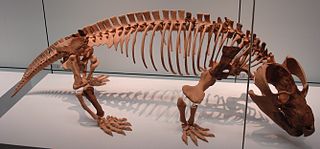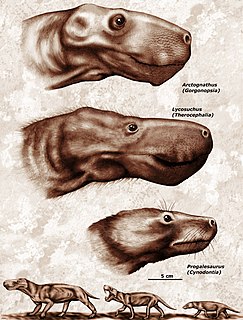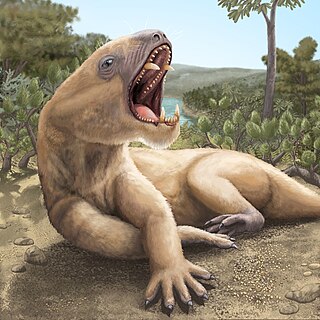
The cynodonts are a clade of therapsids that first appeared in the Late Permian, and extensively diversified after the Permian–Triassic extinction event. Cynodonts had a wide variety of lifestyles, including carnivory and herbivory. Mammals are cynodonts, as are their extinct ancestors and close relatives, having evolved from advanced probainognathian cynodonts during the Late Triassic. All other cynodont lines went extinct, with the last known non-mammalian cynodont group, the Tritylodontidae having its last records in the Early Cretaceous.

Biarmosuchia is an extinct clade of non-mammalian synapsids from the Permian. Biarmosuchians are the most basal group of the therapsids. They were moderately-sized, lightly-built carnivores, intermediate in form between basal sphenacodont "pelycosaurs" and more advanced therapsids. Biarmosuchians were rare components of Permian ecosystems, and the majority of species belong to the clade Burnetiamorpha, which are characterized by elaborate cranial ornamentation.

Therocephalia is an extinct suborder of eutheriodont therapsids from the Permian and Triassic. The therocephalians ("beast-heads") are named after their large skulls, which, along with the structure of their teeth, suggest that they were carnivores. Like other non-mammalian synapsids, therocephalians were once described as "mammal-like reptiles". Therocephalia is the group most closely related to the cynodonts, which gave rise to the mammals. This relationship takes evidence in a variety of skeletal features. The phylogeny of therocephalians has been disputed, as the monophyly of the group and the relationships of its members are unclear.

Tetraceratops insignis is an extinct synapsid from the Early Permian of Texas. It was originally classified as an early and very primitive member of Therapsida, a group that includes mammals and their close extinct relatives. However, it is now seen as a primitive non-therapsid sphenacodont rather than a genuine basal therapsid.

The theriodonts or Theriodontia are a major group of therapsids. They can be defined in traditional, Linnaean terms, in which case they are a suborder of synapsids that lived from the Middle Permian to the Middle Cretaceous, or in cladistic terms, in which case they include not only the traditional theriodonts but also their descendants the mammals as well.

Moschorhinus is an extinct genus of therocephalian in the family Akidnognathidae, with only one species: M. kitchingi. It was a carnivorous, lion-sized synapsid which has been found in the Late Permian to Early Triassic of the South African Karoo Supergroup. It had a broad, blunt snout which bore long, straight canines. It appears to have replaced the gorgonopsids ecologically, and hunted much like a big cat. While most abundant in the Late Permian, it survived a little after the Permian Extinction, though these Triassic individuals had stunted growth.

Biseridens is an extinct genus of anomodont therapsid, and one of the most basal anomodont genera known. Originally known from a partial skull misidentified as an 'eotitanosuchian' in 1997, another well-preserved skull was found in the Xidagou Formation, an outcropping in the Qilian Mountains of Gansu, China, in 2009 that clarified its relationships to anomodonts, such as the dicynodonts.

Baurioidea is a superfamily of therocephalian therapsids. It includes advanced therocephalians such as Regisaurus and Bauria. The superfamily was named by South African paleontologist Robert Broom in 1911. Bauriamorpha, named by D. M. S. Watson and Alfred Romer in 1956, is a junior synonym of Bauriodea.

Nanictidopidae is an extinct family of therocephalian therapsids from the Late Permian. Two genera are currently included in the family, Nanictidops from South Africa and Purlovia from Russia. Nanictidopids have short skulls and were probably herbivorous.

Choerosaurus is an extinct genus of therocephalian therapsids from the Late Permian of South Africa. The type species Choerosaurus dejageri was named by South African paleontologist Sidney H. Haughton from the Tropidostoma Assemblage Zone in 1929.
Blattoidealestes is an extinct genus of therocephalian therapsid from the Middle Permian of South Africa. The type species Blattoidealestes gracilis was named by South African paleontologist Lieuwe Dirk Boonstra from the Tapinocephalus Assemblage Zone in 1954. Dating back to the Middle Permian, Blattoidealestes is one of the oldest therocephalians. It is similar in appearance to the small therocephalian Perplexisaurus from Russia, and may be closely related.
Homodontosaurus is an extinct genus of therocephalian therapsids from the Late Permian of South Africa. The type species Homodontosaurus kitchingi was named by South African paleontologist Robert Broom in 1949. Broom based his description on a small skull found in the Cistecephalus Assemblage Zone near Graaff-Reinet. The skull is very small, at about 55 millimetres (2.2 in) long and 20 millimetres (0.79 in) wide. Homodontosaurus has large eye sockets and an elongated snout. The lower jaw is long, thin, and curved. Numerous small teeth line the upper jaw and are long, pointed, and round in cross-section.
Ictidodon is an extinct genus of therocephalian therapsids from the Late Permian of South Africa. The type species Ictidodon agilis was named by South African paleontologist Robert Broom in 1925. Broom classified Ictidodon in the Scaloposauridae, a group of small-bodied therocephalians that are now thought to be juvenile forms of larger therocephalians. Ictidodon and many other scaloposaurids are now classified as basal members of the clade Baurioidea.
Ictidodraco is an extinct genus of therocephalian therapsids from the Late Permian of South Africa. The type species Ictidodraco longiceps was named by South African paleontologists Robert Broom and John T. Robinson in 1948 from the Cistecephalus Assemblage Zone. Ictidodraco was once classified as a scaloposaurian in the family Silpholestidae. Scaloposauria and Silpholestidae are no longer regarded as valid groups, and Ictidodraco is now classified as a basal member of the clade Baurioidea.
Scalopodon is an extinct genus of therocephalian therapsids from the Late Permian of Russia. The type species Scalopodon tenuisfrons was named in 1999 from the Kotelnichsky District of Kirov Oblast. Scalopodon is known from a single fragmentary holotype specimen including the back of the skull, the left side of the lower jaw and isolated postorbital and prefrontal bones. The skull was found in the Deltavjatia Assemblage Zone, which dates back to the early Wuchiapingian about 260 million years ago. Distinguishing features of Scalopodon include narrow frontal bones and a distinctive sagittal crest along the parietal region at the back of the skull. Scalopodon was originally classified in the family Scaloposauridae, and was the first scaloposaurid found in Russia. More recent studies of therocephalians have found scaloposaurids like Scalopodon to be juvenile forms of larger therocephalians and do not consider Scaloposauridae to be a valid group. Scalopodon and most other scaloposaurids are now classified as basal members of Baurioidea.
Pelictosuchus is an extinct genus of therocephalian therapsids from the Late Permian of South Africa. It is classified in the family Akidnognathidae. The type species Pelictosuchus paucidens was named by South African paleontologist Robert Broom in 1940 from the Dicynodon Assemblage Zone.

Karenites is an extinct genus of therocephalian therapsids from the Late Permian of Russia. The only species is Karenites ornamentatus, named in 1995. Several fossil specimens are known from the town of Kotelnich in Kirov Oblast.
Yikezhaogia is an extinct genus of therocephalian therapsids from the Early Triassic of Mongolia. It is known from a single fragmentary skull and associated postcranial bones representing the species Yikezhaogia megafenestrala. It is identifiable as a therocephalian by its thin postorbital bar behind the eye socket, its elongated temporal opening behind the bar, and a thin lower jaw with a low coronoid process. Large tooth sockets in the upper jaw indicate that Yikezhaogia had large caniniform teeth. The teeth of the lower jaw are blunt-tipped and cylindrical. Although its exact position among therocephalians is uncertain, Yikezhaogia is probably a basal member of the group Baurioidea.
Phthinosaurus is an extinct genus of therapsids from the Middle Permian of Russia. The type species Phthinosaurus borrisiaki was named by Soviet paleontologist Ivan Yefremov in 1940 on the basis of an isolated lower jaw. Because this jaw provides few distinguishing characteristics, the evolutionary relationships of Phthinosaurus are poorly known. Yefremov named the family Phthinosuchidae in 1954 to include Phthinosaurus and the newly named Phthinosuchus, which was described on the basis of a crushed partial skull. American paleontologist Everett C. Olson placed both of these therapsids in the larger infraorder Phthinosuchia in 1961. In 1974 Leonid Tatarinov named the family Phthinosauridae to include Phthinosaurus alone, retaining Phthinosuchus within Phthinosuchidae.

Thliptosaurus is an extinct genus of small kingoriid dicynodont from the latest Permian period of the Karoo Basin in KwaZulu-Natal, South Africa. It contains the type and only known species T. imperforatus. Thliptosaurus is from the upper Daptocephalus Assemblage Zone, making it one of the youngest Permian dicynodonts known, living just prior to the Permian mass extinction. It also represents one of the few small bodied dicynodonts to exist at this time, when most other dicynodonts had large body sizes and many small dicynodonts had gone extinct. The unexpected discovery of Thliptosaurus in a region of the Karoo outside of the historically sampled localities suggests that it may have been part of an endemic local fauna not found in these historic sites. Such under-sampled localities may contain 'hidden diversities' of Permian faunas that are unknown from traditional samples. Thliptosaurus is also unusual for dicynodonts as it lacks a pineal foramen, suggesting that it played a much less important role in thermoregulation than it did for other dicynodonts.















